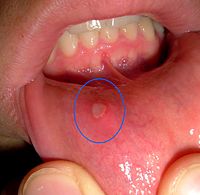
Photo from wikipedia
Objectives To assess the distribution of bone erosions and two erosion scores in the feet of patients with gout and analyze the association between erosion scores and monosodium urate (MSU)… Click to show full abstract
Objectives To assess the distribution of bone erosions and two erosion scores in the feet of patients with gout and analyze the association between erosion scores and monosodium urate (MSU) crystal deposition using dual-energy computed tomography (DECT). Materials and methods We included all patients who underwent DECT of both feet between 2016 and 2019 in our radiology department, with positive detection of MSU deposits. Data on sex, age, treatment, serum urate, and DECT urate volumes were obtained. CT images were analyzed to score bone erosions in 31 sites per foot by using the semi-quantitative method based on the Rheumatoid Arthritis MRI Scoring (RAMRIS) system and the Dalbeth-simplified score. Reproducibility for the two scores was calculated with intraclass correlation coefficients (ICCs). Correlations between clinical features, erosion scores and urate crystal volume were analyzed by the Spearman correlation coefficient (r). Results We studied 61 patients (mean age 62.0 years); 3,751 bones were scored. The first metatarsophalangeal joint and the midfoot were the most involved in terms of frequency and severity of bone erosions. The distribution of bone erosions was not asymmetrical. The intra- and inter-observer reproducibility was similar for the RAMRIS and Dalbeth-simplified scores (ICC 0.93 vs 0.94 and 0.96 vs 0.90). DECT urate volume was significantly correlated with each of the two erosion scores (r = 0.58–0.63, p < 0.001). There was a high correlation between the two scores (r = 0.96, p < 0.001). Conclusions DECT demonstrates that foot erosions are not asymmetric in distribution and predominate at the first ray and midfoot. The two erosion scores are significantly correlated with DECT urate volume. An almost perfect correlation between the RAMRIS and Dalbeth-simplified scores is observed.
Journal Title: PLoS ONE
Year Published: 2021
Link to full text (if available)
Share on Social Media: Sign Up to like & get
recommendations!